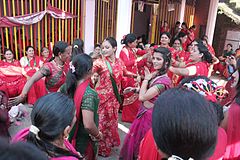
Back তীজ Assamese तीज Bihari তীজ Bengali/Bangla Teej Spanish हरतालिका व्रत Hindi तीज MAI തീജ് Malayalam हरितालिका Marathi तीज Nepali ବାଲି ତୃତୀୟା OR
This article may require cleanup to meet Wikipedia's quality standards. The specific problem is: issues with sourcing, and readability in sizeable parts of the article; specifics have been tagged inline. (September 2020) |
| |
|---|---|
 Women celebrating Haritalika Teej in Nepal | |
| Observed by | Hindu women |
| Liturgical color | Red |
| Type | Hindu |
| Significance | Signifies the penance made by goddess Parvati to receive Shiva as her husband |
| Celebrations | Fasting, worshipping Shiva, gathering, dancing, singing |
| Date | July–September |
| Frequency | Annual |
Teej (Sanskrit: तीज, romanized: Tīja), literally meaning the "third" denoting the third day after the new moon when the monsoon begins as per the Hindu calendar, is a combined name for 3 Hindu festivals primarily dedicated to Hindu deities - the mother goddess Parvati and her male consort Shiva, mainly celebrated by married women and unmarried girls mostly in North India and Nepal to wish for the long life of their husband or future husband and to welcome the arrival of monsoon season with the singing, swings, dancing, enjoyment, prayer rituals and often fasting.
"Teej" is a generic name referring to the three types of Teej festivals - Haryali Teej on the third day after new moon of the Shravana month, Kajari Teej 15 days later, and Hartalika Teej another 15 days later. The Haryali Teej (literally meaning the "green teej"), also known as the Sindhara Teej, Chhoti Teej, Shravana Teej or Sawan Teej, falls on the third day after new moon of the shravana month, marking the day when Shiva consented to goddess Parvati's wish to marry him, celebrated by married women, who visit their parental home and prepare swings on which they then swing and sing happy teej songs. The Kajari Teej (literally meaning the "dark teej"), also known as the Badi Teej, is celebrated 15 days after the "Haryali Teej" during the dark (waxing crescent) phase of the moon. The Hartalika Teej (literally a composite word of "Harat" and "Aalika" meaning "a woman's kidnap with her consent by her female friends"), falls one lunar month after the "Haryali Teej" on the third day after new moon in the month of Bhadrapada which usually falls a day before the Ganesh Chaturthi, it marks the occasion when Parvati encouraged her friends to kidnap her to escape the marriage with Shiva after her father Himalaya wanted to gave her hand in marriage to him. It is celebrated by married women who observe "nirjala vrata" (water-less fast) for the long life of their husband.[1][2]
- ^ Melton, J. Gordon (13 September 2011). Religious Celebrations: An Encyclopedia of Holidays, Festivals, Solemn Observances, and Spiritual Commemorations [2 volumes]: An Encyclopedia of Holidays, Festivals, Solemn Observances, and Spiritual Commemorations. ABC-CLIO. p. 847. ISBN 978-1-59884-206-7.
- ^ "[MITCH EPSTEIN]". Aperture (105): 52–57. 1986. JSTOR 24472056.
© MMXXIII Rich X Search. We shall prevail. All rights reserved. Rich X Search